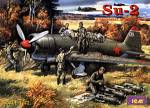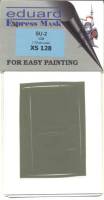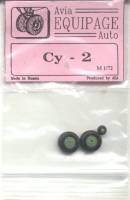


Development of the Su-2 began as far back as the 'Ivanov' specification of 1936; basically, a directive by Stalin for modern attack and reconnaissance machines. The prototypes were developed under the stewardship of the Tupolev Bureau by Pavel Sukhoi's Brigade and was designated ANT-51. The three prototypes--commonly known as SZ-1, -2, and -3-- featured all-metal construction. The wing was a twin-spar unit of three sections, the center being made integral with the fuselage, and was dural skinned. The fuselage was a monocoque structure with very thick (9mm) wood-laminate surfaces, and the metal framed control surfaces were fabric covered.
Handling in the ANT-51 was quite good, and during the SZ-3's State Acceptance Trials in 1940 the NII VVS institute pilots commented favorably on the aircraft. Aileron response was especially light and effective, with well coordinated controls, while the low-speed handling properties were considered safe even for pilots with minimal training. The SZ-3 was also designed for excellent crew protection, large sheets of 9mm armor plate covering the vital cockpit areas.
The aircraft entered production in 1940 as the BB-1 ('blizhniy bombardirovchik'); later in the same year the designation was changed to Su-2 to accomodate the new aircraft naming convention. Powered by the 950 hp M-88 radial, the BB-1 was armed with four ShKAS guns in the wings, a further such weapon being mounted in an MV-5 turret at the aft end of the long canopy. Internal bomb bays accommodated four 100kg bombs, while externally mounted stores ranged from two 250kg weapons to ten RS-82 rockets.
In 1941 production was expanded to two further facilities, and the 1000 hp M-88B engine became standard. Performance in these updated version rose to 233 mph at sea level and 291 mph at 20,400 ft. Batches of Su-2s were also completed at Zavod 135 with the 1400 hp M-82 radial, this variant featuring much improved climb and low altitude performance. Success did not attend the Su-2 in combat, however, and only some 877 Su-2s (and -4s) were completed before production was terminated in 1942.
By far the best reference on the Su-2 is the book Sukhoi Su-2 Short Range Bomber. Except for it being written entirely in Russian, the book is a "must have" and an awesome addition to the VVS library.
In addition, Erik Pilawskii has provided numerous color schemes of all three of the Su-2 variants.
So far it appears the Su-2 has best been kitted in 1/72nd. We know of six companies that have put out 1/72nd Su-2 kits: MPM (vacuform) , Wings 72 (vacuform), Patriot, Alfa/VVS and ICM. In 1/48th, we have been told that Pend Oreille makes a resin Su-2, but we have no further details.
| Patriot | Alex Ruchkovsky supplies the following: "This kit appeared in the early nineties and was a step aside from traditional way to mold and pack model kits. The kit was to start a series called Aero Classics and the instruction sheet was in fact a booklet that attempted to tell the Su-2 and OKB Sukhoi story, and even contained some photos and sketches of the plane. The model was relatively accurate and it showed it was made using the published Su-2 drawings. I remember I was very impressed by neat surface detail, especially rivets, and subtle structure on the inner surface of the landing gear covers. Sadly enough, the general quality of mouldings was terrible, heavy flash, very thick fuselage halves, almost useless small details, incredibly thick transparent part and no decals whatsoever. Manufacturers named their product an "Su-4" thereby meaning an Su-2M-82." Alex has built this kit and included some of the parts from the Alfa kit. This excellent build can be found in the Model Gallery. | |
| Alfa/VVS Models | Alex Ruchkovsky supplies the following: "This kit was in fact older than Patriot, and marginally better. VVS Models has been selling it with terrible decals, rubber tyres and a set of white metal parts that contain a radial engine, a propellor with spinner, main landing gear struts, wheel hubs and a machine gun seemingly copied from some Italeri German bomber kit. Again, outlines of the model were decent, detail scarce, transparency with a tender tinge of pink. I saw VVS Models kits in the Su-2M-88B and Su-2M-82 versions, such kits differentiated by the location of the air intake on the separately molded engine cowling." | |
| Wings 72 | This vacuform builds into the M-88 version out of the "bag" and while detail parts are lacking, the panel lines are engraved and it appears well molded. Instructions are pretty comprehensive and include drawings. All parts are vac and there are no options nor decals within the kit. Unfortunately the kit appears too small in all dimensions so it can not be recommended. |  |
| MPM | John Thompson supplies the following: "The kit includes 21 vacuformed parts, plus one vac canopy; 24 small injected parts, including prop, cockpit details, wheels, landing gear legs and tailwheel, etc. Panel lines on main components are recessed, and look quite good. Fabric detail on control surfaces is also very good. Quality of injected parts is rough, though, and would need considerable cleaning up, but they are usable. Three decal options (Yellow 5, Red 17, White 14 - very little information on instruction sheet re service unit or pilot for each option). One nice feature in comparison to the ICM kit is that the MPM includes vacuformed main wheelwell enclosures, molded separately from the wings. Regarding accuracy, the main components (wings, fuselage, tailplanes) match the ICM kit almost exactly, although a direct comparison (and comparison with drawings) is difficult without cutting these parts free from the backing sheet. Except for the amount of work needed to clean up the injected parts and to assemble any vacuform, it really is quite a good kit!" It appears to build the M-88 version according to the box art. |  |
| ICM | This is the most recent kit released, luckily injected molded. It has come out in two versions, the standard "Su-2" as well as the "Su-2R". We haven't seen the "Su-2R". Out of the box the ICM kit builds into the M-88 and we provide a complete preview. By far it is the best and most accurate of all kits released thus far. |  |
 |
Believe it or not, even though the Su-2 is considered to be obscure in the modeling world, the ICM kit is supported by a lot of aftermarket items. There are four photoetch sets, a set of AML decals and Equipage has released their trademark wheels for the kit (shown at right). In the photoetch realm we have Part, Eduard and Ace provides two separate sets - a a set for the flaps and "general" set. In addition, PH Model has out two conversions, one to make the M-88B version (which includes parts to make the TSS-1 gun mount) and the other to make the M-82 version. One final piece of aftermarket is the canopy mask set provided by Eduard (shown at left). Even with all of these aftermarket sets released there are a few kit areas that could be catered to. While the M-88B PH conversion comes with a vac canopy to build the TSS-1 version, it would be nice to have someone come out with a replacement vac canopy for the standard ICM kit. Moskit hasn't released exhausts for it yet (although with ICM providing indented exhausts, drilling out the kit exhausts is a possibility). Plus, since ICM doesn't have anything that could warrent enclosed gear wells resin additions in this area would be very welcome. Another area that could be supported by something aftermarket would be the area in and around the fuselage underside "tunnel gun" so it can be shown in the deployed position. |  |
All four photoetch sets are extremely well done. Eduard provides replacement undercarriage doors while the others do not. Part provides photoetch canopy frames while the others do not. Ace's interior bits - especially for the navigator/gunner/bombadier's rear cockpit area - are extremly comprehensive and leave little out. Ace's flaps are also well done, but if you have no desire to replace the kit's flaps then you don't have to buy the separate set. Since the Ace photoetch set is unfortunately difficult to come by you could go with either the Eduard or Part set. Base your decision on if you want to replace the flaps or not. However, if you buy either the Ace or the Part set, then you have to deal with the kit's undercarriage doors. In my opinion any injected plastic kit doors provided in 1/72nd scale are too thick and either need to be sanded down or replaced. Replacing them is an option with the Eduard set. If you can find the Ace set and have no fear of small brass parts then by all means pick it up. I like it the best out of the three for interior details. If you have the money then also buy the Eduard set for the exterior bits. This is not to belittle Eduard or anything but if they came out with a Zoom set for the Su-2, then by all means it should include the replacement undercarriage items as well as the separate bomb racks for under the wings.